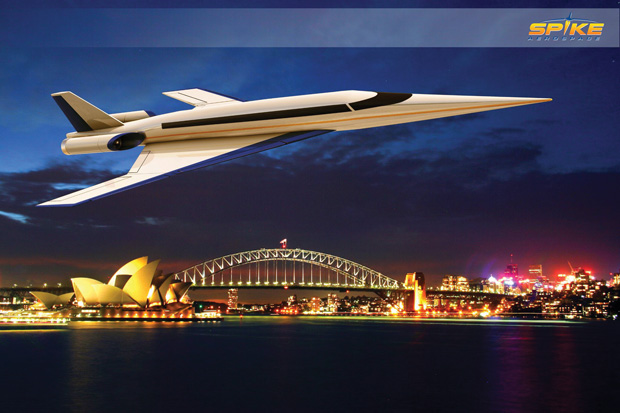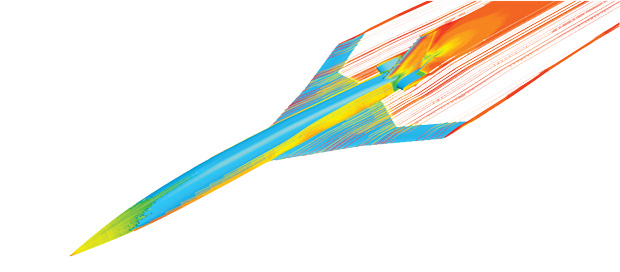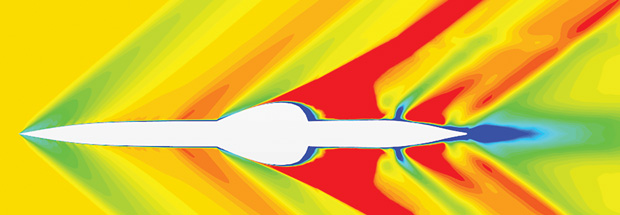
A rendering of the Spike S-512 supersonic business jet. Image courtesy of Spike Aerospace.
Latest News
October 3, 2016
Spike Aerospace, a Boston-based aerospace firm, wants to make your business travel faster. The company is currently designing what could be the first commercial supersonic business jet, the Spike S-512. Once the plane is in operation, it could cut overseas travel times in half by reaching cruising speeds of Mach 1.4 to 1.6—and do so without the unsettling sonic boom that has kept supersonic aircraft from traveling over land in the U.S. for decades.
“It will be able to reach London from New York in three or four hours,” says Vik Kachoria, Spike president and CEO, and a veteran of GE Aviation and NASA. “It’s really designed for business travelers. I was traveling a lot when this project started and wondered why there hadn’t been a replacement to the Concorde. You can’t build another airline-size supersonic aircraft, but a business jet makes sense.”
Using proprietary technology developed by Spike, the new jet design (in the works since 2013) will minimize the sonic boom of the plane by optimizing its aerodynamics. To help create the new supersonic jet, Spike has partnered with MAYA Simulation and Siemens PLM Software to leverage their experience in CAE and simulation.
“The power of software tools has really accelerated over the past few years, which has improved engineering efforts, analysis, design and verification,” Kachoria says. “Smaller companies like ours can take advantage of those new technologies because we don’t have the investment in those older legacy methods.”
Simulation has been a key part of the design process. “We can design the entire thing on a screen, twist and turn, and get it right the first time,” Kachoria says. “We don’t have to spend a lot of time and money acquiring tooling and materials to build it. The simulation can do an amazing job.”
“For such a small company, the cost of testing all the different scenarios would be prohibitive, if they had to go into a wind tunnel to validate the design iterations,” says Marc Lafontaine, director at MAYA, a Montreal-based Siemens partner. “Smaller companies going into aerospace projects have to very quickly come up with the right design and have to make sure the design is viable at every step because they don’t have infinite funds. They need upfront flexibility for looking at many scenarios and finding the best one, and they can do it at a fraction of the cost it would take to [physically] test every iteration.”
Dormant Market for Supersonic Air Travel
Supersonic aircraft have been around since the 1940s, but have been used primarily by the military or for experimental purposes.
Only two types of supersonic planes have been used commercially: The Russian Tupolev Tu-144 (the first commercial supersonic transport aircraft) and the Anglo-French Concorde. The Tu-144 ceased production in the early 1980s. The Concorde was retired in 2003 because of financial viability issues and safety concerns raised after a crash in France that killed 100 passengers. Airbus also discontinued maintenance support for the Concorde after 2001. There were a number of problems with these aircraft, including cabin noise, mechanical failures in the Tu-144 and more.
From a design standpoint, supersonic flight poses a number of challenges, including intense heat generated at faster speeds, forces applied to the aircraft’s structure during banks and turns, and noise generation.
“Supersonic adds a significant level of magnitude in difficulty,” Kachoria says. “You have to be so much more aware of fuel burn, and if you can’t manage that, it’s a non-starter. You have to optimize the aircraft to minimize drag, and there are stability issues, airflow and other design challenges.”
There were also economic challenges faced by supersonic airliners, including fluctuating aircraft fuel prices and the fact that subsonic flight appeared to be more profitable for the airlines that previously flew the Concorde.
That’s why there is now interest in what is known as the supersonic business jet, a class of smaller aircraft that would transport fewer than 20 passengers. In addition to Spike’s S-512 (which will hold 18 passengers), there are a number of other projects underway including the Aerion AS2, HyperMach’s SonicStar, Tupolev’s proposed Tu-444, the SAI Quiet Supersonic Transport, as well as announced projects in Germany, Japan and elsewhere.
The market for these jets is potentially limited to transoceanic flights because of the loud sonic booms that supersonic planes produce. In the U.S., overland flight has been banned for decades because of noise concerns. However, research firm Technavio thinks the market for such aircraft could reach $3 billion by 2020, even though the first planes have yet to be manufactured.
Spike is hoping its Quiet Supersonic Flight (QSF) technology will propel its plane to the head of the pack, with the first jet to be available in the early 2020s. Spike’s low-boom concept would allow for trans-continental travel at speeds up to Mach 1.6. That type of aircraft would have a much stronger business case than the old Concorde’s, which could only ferry passengers to a limited number of destinations.
A Quieter Ride
QSF is a proprietary technology that works by optimizing the design of the wing, fuselage and tail to minimize noise created by the plane’s sonic wake. It’s based on the principle that, generally speaking, the longer and “pointier” the plane is, the less turbulence it will experience.
Aerodynamic studies used to have to be done in a wind tunnel, but that poses a number of physical challenges that can skew the results. Computational fluid dynamics (CFD) can replace the wind tunnel during the early design phases, substantially reducing the cost of designing the aircraft and making it easier for Spike to run through hundreds of potential iterations.
 Spike Aerospace used CD-adapco’s STAR-CCM+ to address design challenges for aerodynamics, heat transfer and stress. Image courtesy of CD-adapco.
Spike Aerospace used CD-adapco’s STAR-CCM+ to address design challenges for aerodynamics, heat transfer and stress. Image courtesy of CD-adapco.As part of its efforts to get to the right design faster, Spike partnered with MAYA Simulation Technologies, which offers training and consulting services in the advanced thermal and fluid flow analysis space, and offers the full suite of Siemens PLM Simulation software solutions.
“We are providing expertise in helping them run their CFD, do external calculations and making sure they can get to the next step, which is doing structural work and enabling the designers to work more efficiently,” Lafontaine says. “CFD was an early requirement, because that’s how they get to envelope analysis and get the performance they want with no noise or vibration.”
Spike is using CD-adapco CAE and CFD tools along with Siemens NX CAD in the design of the jet. The company has tested other tools as well. “For the past year, we’ve experimented with different systems to see how they compare, and the integration between the simulation and CAD tools with Siemens is very tight,” Kachoria says. “You can have a new solid created and go through analysis again very rapidly.”
The company is using CD-adapco’s STAR-CCM+ to simulate and analyze flow, heat transfer and stress issues in the design. “We chose STAR-CCM+ because of its meshing aspects,” Kachoria says. “We can rapidly create a mesh and then fit it tightly against the edges of the aircraft, and it was easier for our engineers to do. We are able to take the analysis and have the CAD guys update the design using that data. It’s a fairly tight integration.”
For example, the company is optimizing the wing configuration on the aircraft using aerodynamic analysis for various angles and increasing speeds, from subsonic to supersonic. “We can do rapid analysis, hundreds of times per day,” Kachoria says. “We’ve worked with MAYA and Siemens to use technology to accelerate our optimization studies and to improve aerodynamic performance of the wing using NX CAD and STAR-CCM+ simulation.”
Engineers have individual workstations, and the CFD and post-processing work is done on a high-performance cluster that was installed along with the Siemens deployment. MAYA and Siemens worked with cloud-based HPC (high-performance computing) provider Rescale to get Spike up and running quickly, supporting their simulation capabilities.
“Setting up a high-performance cluster would have required a dedicated team to understand how to connect the cores and do parallel processing and validation, and it takes a tremendous amount of time and capital to do that,” Kachoria says. “MAYA, Siemens and Rescale got the HPC cluster up and running in two weeks, and we were ready in less than a month with almost no upfront cost. As we need to scale it up and do more complex work or access more memory, we can do that as needed. We didn’t spend a million dollars, and we didn’t hire any additional IT people. Within weeks were able to do some amazing calculations and analysis.”
The company has completed its baseline study on the design and aerodynamics, and is now working on optimizing the aircraft structure. “We can reduce the sonic boom aspects and increase efficiencies, so this is tied into our sonic boom analysis capabilities,” Kachoria says. “We have analysis in the CFD environment, and the sonic boom guys look at that. Eventually they will reach a convergence and agree on what the best solution is to all of this.”
 Simulation, such as this CFD one show here, has been a key part of the design process for the Spike S-512. Image courtesy of CD-adapco.
Simulation, such as this CFD one show here, has been a key part of the design process for the Spike S-512. Image courtesy of CD-adapco.Kachoria says that the technology has made it possible to reach this stage much faster than would have been possible just a few years ago. “I’m amazed at how much can be done now sitting at a desktop without bending any metal,” Kachoria says. “None of this is real until we build the model and see how the analysis comes out, but we’ve developed enough confidence that we know we are on the right track, and we’ll get to the final design a lot faster than we would have in the past.”
The company plans to begin detailed engineering in late 2017, and the first test flight of the aircraft is scheduled for 2020. “Once they have the shape they want to have, they will be iterating to determine the final structure and how to manufacture it,” Lafontaine says.
The Siemens platform will also help Spike efficiently share their design work with other companies to help complete construction of the final aircraft.
“We are going to see rapid advances in aerospace because of these digital tools,” Kachoria says. “We can do everything faster, and that’s going to help Spike and other companies make some amazing changes happen.”
More Info
Subscribe to our FREE magazine, FREE email newsletters or both!
Latest News
About the Author
Brian Albright is the editorial director of Digital Engineering. Contact him at [email protected].
Follow DE






